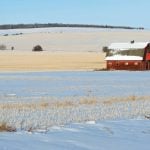There are a record number of new varieties on their way up to seek registration with the CFIA after the Prairie Recommending Committee for Wheat, Rye and Triticale recently met in Saskatoon.
The body responsible for recommending new varieties for registration had 41 cultivars under the microscope this year, with 37 earning the green light.
The committee has previously seen lists in the high 30s.
Why it matters: A new crop of cultivars has cleared a major hurdle to registration and is on the way to the CFIA after earned recommendations from the PRCWRT.
Read Also

Still hard to predict precise fertilizer payback
Despite decades of advances, international research finds no clear answer for where and when adding nutrient will fail to boost growth.
Jamie Lardner, committee chair, pointed to the body’s operational overhaul several years ago.
The recommending committee looked to modernize its operations in 2013, following requests from then federal ag minister Gerry Ritz.
“That’s really opened the door to things being really transparent, (and) straightforward to get things through,” Lardner said. “There’s a lot of things kind of involved, but this shows that now the marketplace is being filled with lots of different varieties from lots of different companies. Farmers really have options in terms of what they might want for their area.”
- Read more: Opinion: The ongoing class struggle
- Read more: The wheat class review process
The committee’s operational changes included a shift in the voting process, so that varieties approved independently by the committee’s agronomy, disease and quality evaluation groups would automatically be nominated for recommendation.
The committee’s size and motions on data sharing have both also been brought up since 2013, while issues such as soil test requirements came to the fore this year.
Variety trends
Disease resistance and yield have been particular highlights in the varieties now recommended to the CFIA.
New spring wheat cultivars have been showing substantial yield bumps, according to Larsen.
“My colleagues in the disease evaluation team made comments that breeders are doing a fantastic job of meeting all the requirements for disease,” he added. “Before, it used to be there would be the odd weakness that was pretty general. No line would be perfect and there were many lines this year that met the requirements in all cases. So disease resistance is improving.”
Many of the varieties flagged by the recommending committee still came from disease evaluation.
Of those flagged for disease (such as CWRS variety LCS Rebel, pitched for its high yield and relative maintenance of protein levels, but mildly susceptible to leaf rust) developers argued that registration would allow varieties to be published in seed guides, along with appropriate advice on how to manage for weaknesses, while still making them available for their desirable traits, such as resistance to other diseases, yield or milling quality.
One fall rye variety, RT240, brought forward by KWS Lochow, made a successful bid with the committee for interim registration for decreased ergot, while keeping comparable yield to other hybrids.
“This could be sold directly into the market without cleaning,” the room heard from the developer, something he estimated would save farmers $50 an acre in cleaning costs.
















